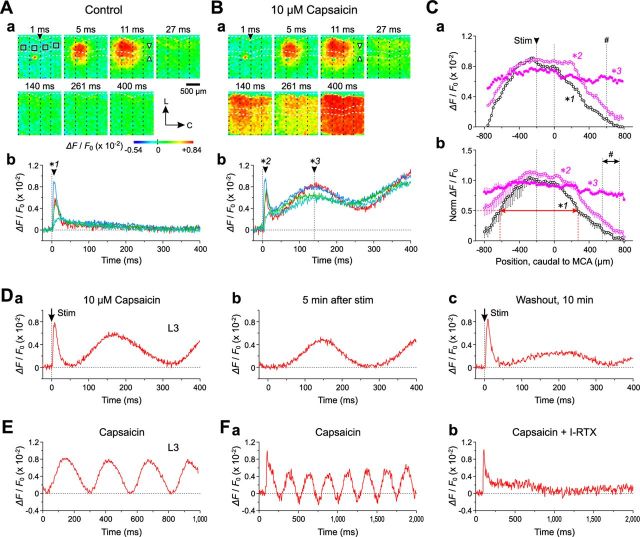Figure 6.
Facilitation of oscillatory synchronization between Gu-I and Au-I by stronger L4 stimulation. Aa, Ba, Sample pseudocolor images of optical responses induced in the absence (A) and presence (B) of 10 μm capsaicin by 6 μA (=1.8 × Th*) L4 stimulation applied to a site 200 μm rostral to MCA (filled arrowheads) in L4 of Gu-I in a slice with the boundary (open arrowheads) between Gu-I (DI region) and Au-I (GI/DI region) at 600 μm caudal to MCA. The vertical dotted lines showing the presumed column boundaries. The four columns were assigned numbers 1–4 from left to right. The black squares represent ROIs in columns 1–4. L, Lateral; C, caudal. Ab, Bb, Temporal profiles at L3 ROIs in columns 1–4 represented by red, blue, green, and cyan traces, respectively, in the absence (Ab) and presence (Bb) of capsaicin. The filled arrowheads indicate the peak time points of the initial responses (*1 and *2) and the second wave (*3). Ca, Horizontal spatial profile of the optical response in L3 at the time point of *1 (black circles) shown in Ab and at the time points of *2 (purple open circles) and *3 (purple filled circles) shown in Bb. The pound sign (#) indicates the position of the border between Gu-I and Au-I. Cb, Averaged (±SD) horizontal profiles (n = 5) at the peak time points of the initial sharp response in the absence and presence of capsaicin (black and purple open circles, respectively) and at the peak time points of the second waves in the presence of capsaicin (purple filled circles). The pound sign (#) indicates the positions of the borders between Gu-I and Au-I ranging from 550 to 750 μm caudal to MCA. Red left–right arrow indicates the half-width of the horizontal profile. D, A representative example of an initial sharp response followed by a slow oscillation induced in the presence of 10 μm capsaicin by 6 μA L4 stimulation (a). Persistence of the oscillation 5 min after single stimulation (b). Marked diminution of the slow oscillation following the unaltered initial response 10 min after capsaicin washout (c). E, Once triggered, the oscillation persisted as long as capsaicin (5 μm) was present. F, I-RTX (0.5 μm) addition to the perfusate including capsaicin (10 μm) abolished the capsaicin-induced oscillatory response, leaving the initial response unaffected (a, b).

